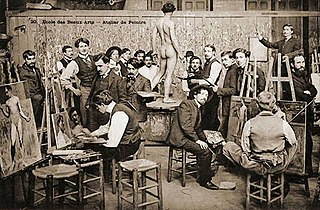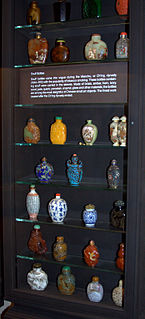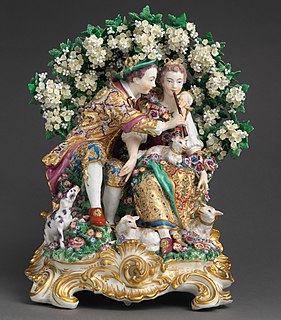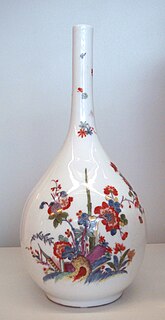This article includes a list of references, related reading or external links, but its sources remain unclear because it lacks inline citations .(August 2019) (Learn how and when to remove this template message) |
The Limoges Box is type of small hinged porcelain trinket box produced by Limoges porcelain factories near the city of Limoges, France. They are made of hard-paste porcelain and collected worldwide.

Porcelain is a ceramic material made by heating materials, generally including kaolin, in a kiln to temperatures between 1,200 and 1,400 °C. The toughness, strength, and translucence of porcelain, relative to other types of pottery, arises mainly from vitrification and the formation of the mineral mullite within the body at these high temperatures. Though definitions vary, porcelain can be divided into three main categories: hard-paste, soft-paste and bone china. The category that an object belongs to depends on the composition of the paste used to make the body of the porcelain object and the firing conditions.

Limoges porcelain is hard-paste porcelain produced by factories in and around the city of Limoges, France beginning in the late 18th century, but does not refer to a particular manufacturer. By about 1830 Limoges, which was close to the areas where suitable clay was found, had replaced Paris as the main centre for private porcelain factories, although the state-owned Sèvres porcelain near Paris remained dominant at the very top of the market. Limoges has maintained this position to the present day.

Hard-paste porcelain, sometimes "true porcelain", is a ceramic material that was originally made from a compound of the feldspathic rock petuntse and kaolin fired at very high temperature, usually around 1400 °C. It was first made in China around the 7th or 8th century, and has remained the most common type of Chinese porcelain.
Limoges porcelain boxes were first created in the mid-18th century after Jacques Turgot, Finance Minister of King Louis XVI, gave a Royal edict to the city of Limoges, France the exclusive right to produce Royal Limoges porcelain for the Kingdom of France. The first Limoges trinket boxes were long narrow containers that were created for expensive needles. From here, other shapes of limoges porcelain boxes evolved. The earliest were those that held thimbles and embroidery scissors and then round flat Limoges boxes were formed and used as powder boxes, and/or snuff boxes. Under Louis XIV these small boxes were used to hold a lock of lady's hair or small poem.

Louis XVI, born Louis-Auguste, was the last King of France before the fall of the monarchy during the French Revolution. He was referred to as citizen Louis Capet during the four months before he was guillotined. In 1765, at the death of his father, Louis, son and heir apparent of Louis XV, Louis-Auguste became the new Dauphin of France. Upon his grandfather's death on 10 May 1774, he assumed the title "King of France and Navarre", which he used until 4 September 1791, when he received the title of "King of the French" until the monarchy was abolished on 21 September 1792.
Exactly when and who made the first porcelain snuffbox is up for debate. There were faience snuffboxes that were produced sometime around 1730. These cannot be identified by back stamp marks, for none were put on them. There were four big porcelain factories that made snuff boxes around this time, Chantilly porcelain (1725–1800), Saint-Cloud porcelain (1677–1766), Mennecy porcelain (1734–73), and the royal Vincennes porcelain (1740–56), which moved to become Sèvres porcelain (1756–present). Additionally independent makers produced them with no signature or marking.

Faience or faïence is the conventional name in English for fine tin-glazed pottery on a buff earthenware body, at least when there is no more usual English name for the type concerned. The invention of a white pottery glaze suitable for painted decoration, by the addition of an oxide of tin to the slip of a lead glaze, was a major advance in the history of pottery. The invention seems to have been made in Iran or the Middle East before the ninth century. A kiln capable of producing temperatures exceeding 1,000 °C (1,830 °F) was required to achieve this result, the result of millennia of refined pottery-making traditions. The term is now used for a wide variety of pottery from several parts of the world, including many types of European painted wares, often produced as cheaper versions of porcelain styles.

Chantilly porcelain is French soft-paste porcelain produced between 1730 and 1800 by the manufactory of Chantilly in Oise, France. The wares are usually divided into three periods, 1730-51, 1751-1760, and a gradual decline from 1760 to 1800.

Saint-Cloud porcelain was a type of soft-paste porcelain produced in the French town of Saint-Cloud from the late 17th to the mid 18th century.
Snuff eventually went out of fashion around the time of the French Revolution but putting pills in Limoges boxes became popular. During the Victorian era the Limoges boxes lost popularity again until the 1970s when people began to carry their pills in the Limoges porcelain boxes. In the 20th century they became popularly used as pillboxes.

The French Revolution was a period of far-reaching social and political upheaval in France and its colonies beginning in 1789. The Revolution overthrew the monarchy, established a republic, catalyzed violent periods of political turmoil, and finally culminated in a dictatorship under Napoleon who brought many of its principles to areas he conquered in Western Europe and beyond. Inspired by liberal and radical ideas, the Revolution profoundly altered the course of modern history, triggering the global decline of absolute monarchies while replacing them with republics and liberal democracies. Through the Revolutionary Wars, it unleashed a wave of global conflicts that extended from the Caribbean to the Middle East. Historians widely regard the Revolution as one of the most important events in human history.

In the history of the United Kingdom, the Victorian era was the period of Queen Victoria's reign, from 20 June 1837 until her death on 22 January 1901. The era followed the Georgian period and preceded the Edwardian period, and its later half overlaps with the first part of the Belle Époque era of Continental Europe. In terms of moral sensibilities and political reforms, this period began with the passage of the Reform Act 1832. There was a strong religious drive for higher moral standards led by the nonconformist churches, such as the Methodist, and the Evangelical wing of the established Church of England. Britain's relations with the other Great Powers were driven by the colonial antagonism of the Great Game with Russia, climaxing during the Crimean War; a Pax Britannica of international free trade was maintained by the country's naval and industrial supremacy. Britain embarked on global imperial expansion, particularly in Asia and Africa, which made the British Empire the largest empire in history. National self-confidence peaked.
The creation of the Limoges Porcelain box is an arduous and time intensive process of creating a master mold, detail painting by hand of color and design, performing multiple firings and glazing upon the porcelain mold, and a final touch of a metal hinge for opening and closing. The painting of the Limoges porcelain in the Limoges box industry are accomplished by small handed French artisans, as experts at the fine brush strokes required for such detailed work. After painting, there are multiple firings. The final firing at a temperature of 1400C is unique to Limoges, giving them a very fine pure and strong white finish. The final touch to a Limoges box is the metal hinged mountings that are meticulously fitted to the finished box. The entire work process is made by hand, so small variations are the norm, thus making each piece really unique. Each model is often made in very limited numbers, & signed by the artists or the atelier.

An atelier is the private workshop or studio of a professional artist in the fine or decorative arts, where a principal master and a number of assistants, students, and apprentices can work together producing pieces of fine art or visual art released under the master's name or supervision.
Limoges boxes once were often gold boxes that contained portraits of king and other political figures. Napoleon I was one of the great snuffbox collectors, he had about 100 gold portrait boxes made as tokens of appreciation from his political supporters.


















